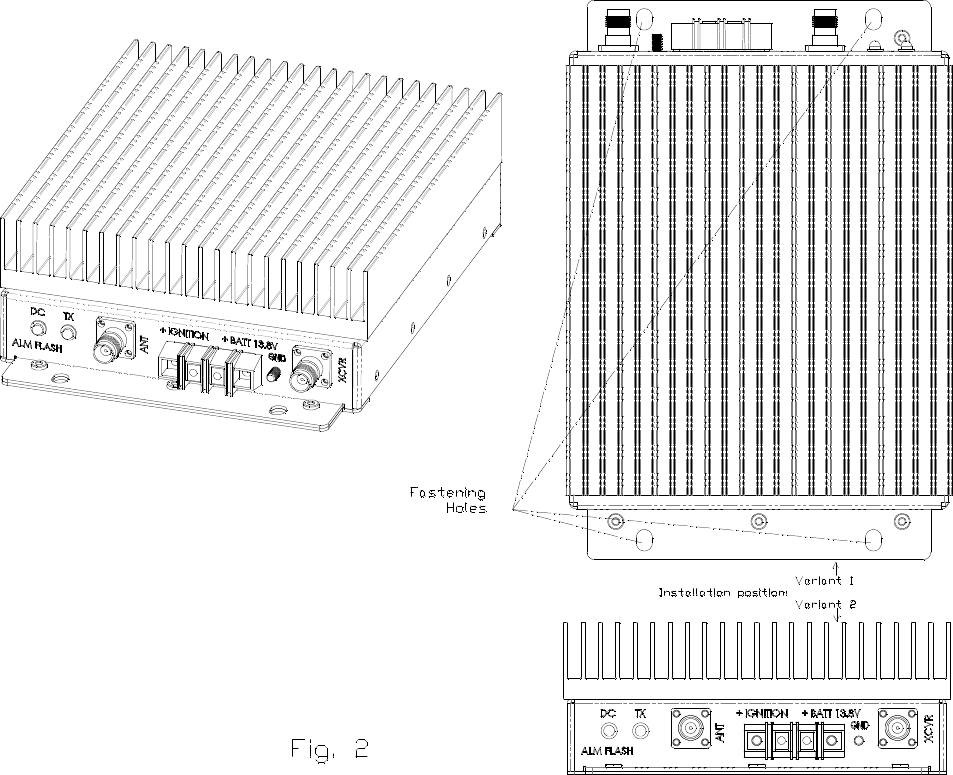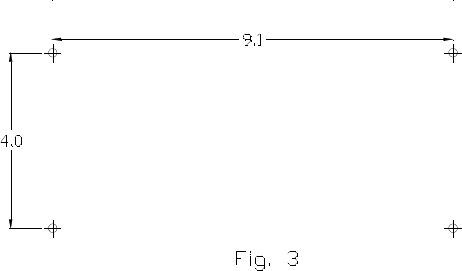Crescend Technologies DSDTV100XX 100W VHF MOBILE AMPLIFIER User Manual DSDTV100XX Rev Bx
Crescend Technologies LLC 100W VHF MOBILE AMPLIFIER DSDTV100XX Rev Bx
Revised Users Manual

User Manual: DSDTV100XX VHF Mobile Power Amplifier
1. General Information
This is a 100W mobile VHF amplifier. It is intended for amplification of single carrier phase
(frequency) modulated narrowband signals in the 136-174 MHz frequency range. The input
power is divided into several ranges. Be sure to operate within the specified range. PIN diode
switching is used to switch between transmit and receive.
2. Construction
The unit is assembled in the chassis with heatsink, intended for convection cooling (see Fig 2).
Unit dimensions are 2.8” x 6.8” x 9.8”.

2
3. Installation
Install the unit in one of two positions, showed at the right side of Fig. 2: vertical or horizontal.
The proper air access to the unit shall be provided: no obstacle for air is allowed closer than 3”
from heatsink. Also, make sure that status LED can be monitored.
Screws from # 10 to # 1/4-20 are recommended. See the fastening holes positions in Fig. 3.
Use copper wires # 10 AWG shall be used for connecting to clamps “+ BATT” and “GND”. Use
copper wire from # 16 AWG to # 12 may by used for connecting to clamp “+ IGNITION”. Wires
shall be crimped for making ring terminals.
Connect the clamp “GND” to the car nearest ground screw of suitable size.
Connect the clamp “+ BATT” to the pole “+” of car battery. Use 30 A fuse for protection.
Connect the clamp “+ IGNITION” to the output of car ignition key that is able to provide not less
than 8 V and not less than 3 mA when it is keyed on. Use 0.5 A fuse for protection.
Use 50 Ohm coax cables with THC (M) connectors for connecting to “XCVR” and “ANT” .
Connect the port “XCVR” to RF output of radio.
Connect the port “ANT” to antenna.
4. Operation
- LED “DC” goes on continuously, when the car ignition key is ON position;
- LED “TX” goes on continuously, when the RF input power is greater ~1/3 of minimum
rated level (see Table 1);
- The continuous transmit time should not exceed 2 min, and the duty cycle should not be
greater than 25% to avoiding overheating;
- In the case of overheating (the heatsink temperature reaches +85ºC) the unit switches to
RX mode, and LED “DC” starts flashing (independently of input power);
- If the load VSWR exceeds 2-3:1, the output power reduces, and LED “DC” starts flashing,
when RF signal is applied to the input.'

3
5. Warning Statements
FCC Part 15.21 Warning Statement-
NOTE: THE GRANTEE IS NOT RESPONSIBLE FOR ANY CHANGES OR MODIFICATIONS NOT
EXPRESSLY APPROVED BY THE PARTY RESPONSIBLE FOR COMPLIANCE. SUCH MODIFICATIONS
COULD VOID THE USER’S AUTHORITY TO OPERATE THE EQUIPMENT.
FCC Part 15.19 Warning Statement- (Required for all Part 15 devices)
THIS DEVICE COMPLIES WITH PART 15 OF THE FCC RULES. OPERATION IS SUBJECT TO THE
FOLLOWING TWO CONDITIONS: (1) THIS DEVICE MAY NOT CAUSE HARMFUL INTERFERENCE, AND
(2) THIS DEVICE MUST ACCEPT ANY INTERFERENCE RECEIVED, INCLUDING INTERFERENCE THAT
MAY CAUSE UNDESIRED OPERATION.
FCC Part 90.203(e) Compliance
This radio complies with 47 CFR Part 90.203(e) in that the operator cannot program and transmit
on frequencies, other than those stated by the manufacturer, service or maintenance personnel,
using the equipment's external operation controls. It is noted that the FCC rules would be
violated if this radio is used to operate on frequencies outside of FCC (Part 90 and Part 22)
Frequency Bands for users other than the (Federal Government).
FCC RF Exposure Requirements
CAUTION: This transmitter must be restricted to work related operations in a Controlled RF
exposure environment. All qualified end-users of this device must have the knowledge to control
their exposure conditions and/or duration, and the exposure conditions and/or duration of their
passengers and bystanders, to comply with the General Population / Uncontrolled MPE limit and
requirements.
Vehicle – Antenna Installation Instructions
The antenna(s) used for this transmitter must be installed to provide a separation distance of at
least 1.8m from all persons, must not be co-located or operating in conjunction with any other
antenna or transmitter, and must not exceed an antenna gain of 0 dBi with a minimum cable loss
of 1dB.
The antenna used for this transmitter must be mounted on the center of the roof ONLY and must
be installed in vehicle having the following characteristics in order to prevent bystanders or
passengers from being exposed to levels exceeding the limits set for General
Population/Uncontrolled Exposure environment:
4
·
All passengers must be sitting under a solid metal roof
·
Rooftop width must be at least 153.5 inches (or 3.9m) OR the edges of the physical boundary
of the vehicle must be at least 3.9m apart.
Failure to observe these restrictions will result in exceeding the FCC RF exposure limits.
IC RSS-GEN, Sec 7.1.2 Warning Statement- (Required for Transmitters)
ENGLISH:
Under Industry Canada regulations, this radio transmitter may only operate using an antenna of a
type and maximum (or lesser) gain approved for the transmitter by Industry Canada. To reduce
potential radio interference to other users, the antenna type and its gain should be so chosen
that the equivalent isotropically radiated power (e.i.r.p.) is not more than that necessary for
successful communication.
FRENCH:
Conformément à la réglementation d'Industrie Canada, le présent émetteur radio peut
fonctionner avec une antenne d'un type et d'un gain maximal (ou inférieur) approuvé pour
l'émetteur par Industrie Canada. Dans le but de réduire les risques de brouillage radioélectrique à
l'intention des autres utilisateurs, il faut choisir le type d'antenne et son gain de sorte que la
puissance isotrope rayonnée quivalente (p.i.r.e.) ne dépassepas l'intensité nécessaire à
l'établissement d'une communication satisfaisante.
IC RSS-102, Sec 2.6 Warning Statements
ENGLISH:
The applicant is responsible for providing proper instructions to the user of the radio device, and
any usage restrictions, including limits of exposure durations. The user manual shall provide
installation and operation instructions, as well as any special usage conditions, to ensure
compliance with SAR and/or RF field strength limits. For instance, compliance distance shall be
clearly stated in the user manual.
The user manual of devices intended for controlled use shall also include information relating to
the operating characteristics of the device; the operating instructions to ensure compliance with
SAR and/or RF field strength limits; information on the installation and operation of accessories
to ensure compliance with SAR and/or RF field strength limits; and contact information where the
user can obtain Canadian information on RF exposure and compliance. Other related information
may also be included.
FRENCH:
Le demandeur est tenu de fournir des instructions appropriées à l'utilisateur de l'appareil de
radio, et des restrictions d'utilisation, y compris les limites de durée d'exposition. Le mode
d'emploi doit fournir installation et de fonctionnement des instructions, ainsi que les conditions
d'utilisation particulières, pour assurer la conformité avec SAR et / ou les limites d'intensité de
5
champ RF. Par exemple, la distance de conformité doit être clairement indiqué dans le mode
d'emploi.
Le manuel d'utilisation de dispositifs destinés à un usage contrôlé doit également contenir des
informations sur les caractéristiques de fonctionnement de l'appareil, les instructions de
fonctionnement pour assurer la conformité avec SAR et / ou les limites d'intensité de champ RF;
informations sur l'installation et le fonctionnement des accessoires pour assurer le respect SAR et
/ ou les limites d'intensité de champ RF, et les informations de contact où l'utilisateur peut
obtenir des informations sur l'exposition canadienne de radiofréquences et la conformité. Autres
renseignements connexes peuvent également être inclus.